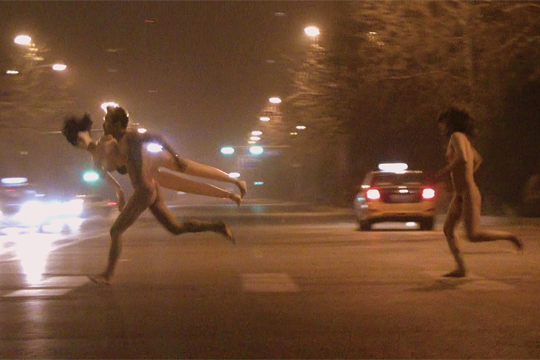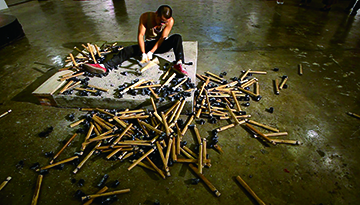LI BINYUAN: JOYFUL EXPLOSIONS
| October 12, 2013 | Post In LEAP 23

AS A YOUNG artist heading towards and steadily exploring maturity, Li Binyuan brings, on at least two different levels, a degree of tension to the origins of his art: one is in the manufactured grammar that has emerged in modern poetry, and the other in the physical essence of the sculpting experience.
As a former president of the Blank Poetry Society, a student-run literary society at the Central Academy of Fine Arts, Li Binyuan had the opportunity to make the acquaintance of many contemporary poets through his work organizing readings, lectures, folk performances, and other activities. These associations and activities have lent a perceptible influence to his art. Formal innovation, obsession with the museum or art history, or other tropes of modern art-making do not hold any sway over Li’s practice.
Even in Li Binyuan’s “social” artworks— for example, the 10 times he has gone streaking—little priority is given to focusing on a powerful concept. He does not rely on the ideological reputation of “social sculpture,” à la Beuys, to act as a bellwether of conceptual discourse; rather, he considers whether the composition of an artwork is capable or not of arousing people’s emotions, whether it is capable of truly unaffected romanticism.
As a young artist, Li Binyuan might anticipate that his unexpected fame will lead to certain doubt. The vast majority of works in his solo exhibition prove that he is not just someone who “got famous by getting naked,” as the saying goes, but a man who is deeply artistic in both work and life. However, when it comes to formal innovation, conceptual innovation, art history, and other common evaluation standards, the irregularity of his practice seems to lack the hard currency necessary to conquer those within the industry. Works such as Ten Thousand Years Too Long are seen as closer to a student’s homework, insufficient in “atmosphere” or “scale.”
Li Binyuan’s interaction with other artists and art critics has dropped to its lowest point; he is inclined to see his often small-scale and inexpensive creations as a road to inner cultivation. The striving for what the establishment acknowledges as “charming” is rarely expressed in his work; nor does he find so-called “anti-establishment” of any interest. Even a work like Tribute to Dong Cunrui, for its satirization of history, does not meddle with politics with any sense of resentment; rather, it demonstrates a happiness in the artist’s everyday life which cannot but explode outwards and make itself seen. Although of Lin Binyuan’s artworks exhibit a trend towards inner cultivation and away from the standards of the art establishment, they are wonderfully open with their audience. Most people without a grounding or education in art can find something to be excited about in Li’s work. There is a definite sense of humor at the core of works like Bigger with Swaying, Li’s graduation work; if the audience leaves this humor behind and attempts to seek out a sense of metaphysical artistic wisdom, they appear as no more than posers— posers resembling balloons full of carbon dioxide—satirized themselves by the work.
Images of Li the “Streaking Brother” did not spread like wildfire because of vulgar hype; it was instead due precisely to the artwork’s openness with his audience that his photos’ potential for dissemination arose. Their sharing via mobile phones and the Internet unfolded and accumulated as a form of social intercourse between friends. Each time these pictures were exhibited (shared) or curated (through additional commentary and annotations) on Weibo, it was not exhibition for the sake of exhibiting, or even exhibiting for the sake of business, but in order to build a sense of friendly affection between a limited group of friends. If Li Binyuan’s art were unable to cultivate this sense of friendly affection, or bring together a community within everyday life, it could not spread or disseminate as it has.

Under the influence of professor Sui Jianguo, there has been a watershed in the academic mood of the sculpture department at CAFA. Traditions such as knowledge of the body, improvisation, and abstract speculation are no longer considered part of the department’s curriculum. Instead, interest has turned from sculpting sculptures to sculpting the chisel, and from sculpting the chisel to sculpting the artist’s own body; the dichotomy between form and content in traditional creative structures is being broken by increasingly muddled and abstract experiments. Some people worry that this series of changes indicates Hegel’s end of art might come to pass right here at CAFA; with the sculpture department increasingly resembling the performance art department, could this academic movement, apparently more radical than romanticism, ultimately reject art and shift to philosophy or religion?
Li Binyuan’s artworks, it is clear that he has preserved in himself the sort of temperament that comes from sculpting, even if he does not create sculpture in the traditional sense. If compared to the merits of a sculpture, in terms of its model dimensions, it is possible that the work and experience that go into an artwork beforehand have a greater capacity to move people: it is then that tools and materials risk a head-on collision, a fact magnified by Li with the poetics of his labor. Beating a hard target with a tool, the destruction of said target in an attack, the tool recoiling into the artist’s flesh, the intense battle between chisel and artwork and chisel and artist—such ideas frequently appear in Li’s art. He is no longer an Internet star, or even just a funny young man; he comes from the sculpture department, and sweat drips constantly from his brow. In Deathless Love, Li strikes metal chisels against each other, until 161 of them have been smashed and the artist collapses, hands numb, beside the last one remaining. The CAFA sculpture retrospective “Sculpt China,” which was attended by 161 people, displayed so-called aesthetic equality and artistic democracy, but transcending this is one cruel, absolute value: the existence of that which cannot be concealed by the affability of an official’s accent or the window dressing of speculation and profiteering.
The destruction of creativity that has taken place in the CAFA sculpture department in recent years is extremely risky, with the potential to result in both lost opportunities for public sculpture commissions, and the decline of new interesting practices. Only the most capable of young people can keep themselves safe in the torrent, defending the most noble of absolute values with their bodies and will. Li Binyuan will not vanish as a result of this change in direction; he possesses an intense creative frequency, like someone going to work every day, on time and alone. The vast majority of his performance works prove he is still working intensely hard; even if the ultimate aim of his streaking is to use joyousness to arouse the body’s beauty, it nevertheless means that most people, even those not particularly excited by art, will find him rather interesting. There have always been many different types of streaking, but truly positive gestures not only invite curiosity— they also lead to the possibility of an open atmosphere for communication.

